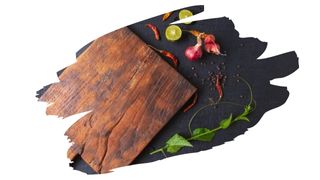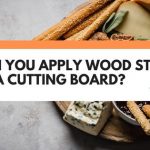Ebony wood is a dense tough lumber. And, due to the oils saturating Ebony, this rot-resistant timber isn’t the easiest lumber to work with.
Thanks to this woods high density, it is tough to machine. Plus, its excess natural tree oils make it difficult to glue and seal.
So, you’ll certainly have your work cut out for you, if you plan on turning this hardwood into a cutting board.
But none of this takes into account the most important thing you need to worry about when it comes to cutting boards; Food Safety.
So, in this post you’ll learn which type of wood you should use for food prepping chopping blocks. You will also find out why Ebony woods incredible toughness can be to its detriment as a cutting board.
And keep reading to discover if Ebony wood is truly safe enough to use as a food prepping surface.

This post may contain affiliate links to products that we receive a commission for (at no additional cost to you). Learn more here.
Which Type Of Wood Is The Most Food Safe Kind For A Cutting Board?
The most food safe wood types fit three key criteria:
1). They Are Easy To Sanitize
Wood is a naturally antibacterial material.
That’s because wood is hygroscopic. Which is the scientific way of saying that wood is superb at absorbing moisture and vapor.
And woods hygroscopy means that wooden cutting boards can quickly draw raw meat juices away from the surface. And this helps to reduce the chance of cross contamination.
However, not all types of wood are suitable for preparing food upon.
Wood types that have large open pores make it easy for bits of meat to get snagged up in them. And once that meat gets snagged up, it can be difficult to thoroughly clean the surface of that chopping board.
This is why you should avoid using large open pored woods for making food prepping surfaces.
2). They Are Tough (But Not Too Tough)
That cutting board needs to be made from wood that is hard enough to not splinter under the chop.
At the same time, wood shouldn’t be so tough that it can potentially blunt and damage your kitchen utensils.
3). They Are Non-Toxic
Avoid using wood types that are toxic, poisonous or are saturated with chemicals.
So of course, this means you should not use poisonous wood species for a chopping board.
Plus, any kind of pressure-treated wood should of course be completely avoided.
Related Post: Walnut Oil Vs Mineral Oil: Which One’s Better For Your Cutting Board?
OK. So Is Ebony Wood Also Strong Enough To Be A Cutting Board?
Well, Ebony wood is strong. So strong, in fact, that it is much too tough to become a regularly used cutting board.
You see, there are different ways to measure the strength of wood. However, when it comes to chopping boards, it’s the compressional strength of wood that really matters.
Compressional strength measures how much compressional stress wood can handle before it becomes crushed.

Now, one way that we measure the compressional strength of wood is by using the Janka Hardness Scale. The Janka rating lets us know how many pounds of force it will take to crush a piece of wood.
For example, one very popular cutting board wood type is Hard Maple (also known as Sugar Maple).
This North American hardwood has a Janka rating of 1450 lbf. That means that it will take 1450 pounds of force to crush this timber.
Ebony wood however, is more than twice as strong as Hard Maple. Thats because Ebony wood has an enormous Janka rating of 3220 lbf!
Related Post: Cherry Vs Maple Cutting Boards (3 Essential Comparisons)
Isn’t That A Good Thing For Cutting Boards? A Tougher Wood Should Last Longer, Right?
When it comes to cutting boards, there is such a thing as too tough. Whilst a very hard tough board will last longer, your kitchen utensils certainly won’t.
This is why there is an optimal Janka rating range for cutting board wood.
Ideally, that wood type should fall between 900 lbf and 1500 lbf. Especially if you plan on using that board for regular food prep.
And this makes Ebony wood just a little too tough for the job of becoming a chopping block.
And Is Ebony Wood Safe? Or Is It Poisonous?
It is not a poisonous timber, but it is what we refer to as being a ‘sensitizer’. And sensitizers are substances that can cause allergic reactions.
For example, wood sawdust (regardless of tree species) is classed as a sensitizer. Inhaling sawdust can give you nausea, and even trigger an asthmatic reaction.
However, there are certain types of wood that can — even in their solid wood form — cause more severe reactions.
This is referred to as ‘contact dermatitis’. And this sort of reaction has been known to occur when musicians play Ebony wood instruments.
Regular direct contact of fingers on an Ebony wood fretboard, (say on a guitar or violin), can cause an itchy rash.
And the same thing could occur if you use Ebony wood to make a cutting board. If someone is particularly allergic to Ebony wood, then handling that cutting board regularly may trigger a similar itchy reaction.
So Is Ebony Wood Good For a Cutting Board?
If it is a decorative board, then you can use this wood.
Ebony wood can also be used for indirect-food-contact surfaces, such as the handles of kitchen utensils. Although you’ll need to seal those handles, (with a durable food-safe sealant), to be safe.
Related Post: 4 Reasons Why You Should NOT Use Polyurethane On A Butcher Block
But if you plan on using Ebony wood for a direct-food-contact surface, then it’s best avoided.
To Wrap Up, Here Are The 3 Key Takeaways From This Post…
- 1). Cutting boards need to be made from non-toxic tough durable wood.
- 2). Ebony is a very tough hardwood, and this means it won’t splinter under the chop. However this wood is so hard that it will damage your kitchen utensils.
- 3). Ebony wood is not a poisonous wood, but it is a very strong sensitizer. Regularly handling unsealed Ebony wood can sometimes trigger an allergic reaction known as ‘contact dermatitis’.
References:
Gambichler, Thilo, Stefanie Boms, and Marcus Freitag. “Contact dermatitis and other skin conditions in instrumental musicians.” BMC dermatology 4.1 (2004): 1-12.



